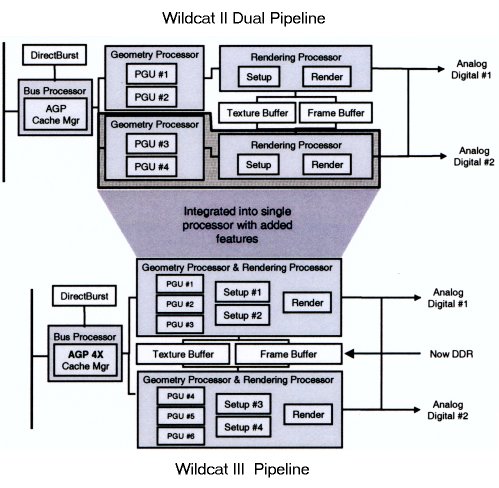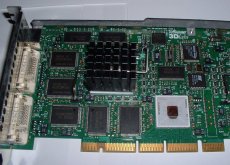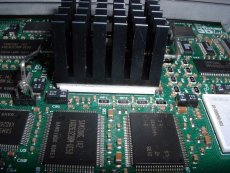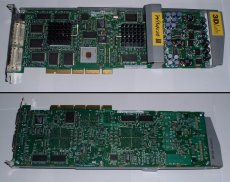 Wildcat III Overview
Wildcat III Overview

3Dlabs first introduced their Wildcat III series on the 4’th of Feb, 2002, replacing their Wildcat II boards as their high end workstation offering.
Here’s a few of the key specifications of Wildcat III:
- Complete Hardware support for OpenGL 1.3
- Multiple T&L Engines
- Volumetric Texture Support
- SuperScene Antialiasing
- Dual Pipeline configuration
- 400 Million Trilinear Filtered Pixels per clock
The Wildcat boards are available in two flavours, The Wildcat III 6110 and Wildcat III 6210. Apart from the various connectors available on the back-panel the main difference between the two options is down to the memory configurations available.
At the release for Wildcat III 3Dlabs outlined the key areas of performance that were increased from the Wildcat II boards, which are as follows:
- Up to 65% increase in T&L Geometry performance
- 2X improvement in line/polygon rendering performance
- Improved anti-aliasing performance from dual setup units
The following diagram gives us some indications as to how these improvements are achieved:

As you can see Wildcat II featured separate geometry and rendering processors, in the case of the dual pipelined board there would be two of each type of unit. For Wildcat III both the geometry and render functions have been integrated on to one chip. However in the process of doing this 3Dlabs also added an extra T&L unit to each pipeline, which gives the 65% improvement in T&L performance; also each pipeline has an extra triangle setup engine, which in turn gives rise to the increased line/polygon performance over its predecessor.
Something to note on the Wildcat board configuration is the fact that there are two entirely separate pipelines, as in render chips -- the chips are scaleable. The pipelines can be used either to power two completely different displays (Wildcat is one of the only boards to be able to render to two separate OpenGL targets) or both pipelines can be used in conjunction with each other to render to one screen, thus doubling the pixel performance. The multi-chip processing is actually done at a pixel level, so each render unit will be processing alternate pixels on each line of the display. The combining of these pixels is a digital process that takes place in the RAMDAC of the unit that is controlling the main display.
Another area of interest is the memory configuration. Wildcat III features several different memory busses: 128 bit DDR busses for the Frame Buffers, 64 bit DDR busses for the texture storage and another 64bit ‘DirectBurst’ bus. The texture RAM can operate in two modes, either with the texture duplicated for both renderers which enables optimum performance, or with the textures pooled and shared between each of the renderers which reduces overall performance but increases lets all the texture RAM be utilised. The ‘DirectBurst’ is also another separate area of memory dedicated to the AGP bus which caches vertex data in order to minimise the calls to the vertex buffer and speed up operations. The Wildcat III 6110 feature 128MB of texture RAM, 64MB of Frame buffer RAM and 16MB of DirectBurst RAM – Wildcat III 6210 doubles each of these elements of RAM to give a total on-board RAM space of 416MB!
Click here if you wish to see a list of Wildcats supported OpenGL extensions



